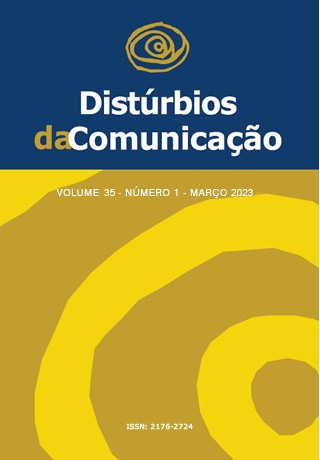Some contributions to the study of childhood stuttering therapeutic process
considerations based on a case
DOI:
https://doi.org/10.23925/2176-2724.2023v35i1e60143Keywords:
Child language, Speech therapy, StutteringAbstract
Introduction: Stuttering is characterized by interruptions in the flow of speech, such as blockages, prolongations, and/or repetitions of sounds, syllables, words, or phrases, commonly identified as atypical disfluencies, often accompanied by other manifestations, such as stuttering anticipatory gestures, negative self-image, tics and/or other bodily manifestations. Objective: to identify the main characteristics that marked the speech of a child who stuttered, reflecting on the moments of fluency and disfluency in the speech therapies, aiming at the study of the therapeutic process. Method: This is a case study with a qualitative approach, based on audio recordings of seven speech-language therapy sessions of a 6-year-old female child (PG), who had stuttered disfluencies and was being treated at a Primary Care Unit. The recordings were transcribed, analyzed and discussed based on the literature. Results: The repetitions were more prevalent; blockages occurred predominantly in plosive phonemes and prolongations, in vowels. Generally, stuttering was intensified when PG was placed in the author’s position and decreased when she did not focus on her speech or her way of speaking, directing her attention to another activity or discursive topic. PG showed a negative relationship with her own speech. The amount of stuttering manifestations decreased throughout the therapeutic sessions. Conclusion: The role of the therapist in the process when dealing with the construction of fluency, self-assurance and the deconstruction of the child’s self-image of a bad speaker expresses the importance of speech therapy in children’s stuttering.
Downloads
References
WHO: World Health Organization. ICD-11 for Mortality and Morbidity Statistics. Version: 02/2022 [Acesso em 15 out 2022]. Disponível em: http://id.who.int/icd/entity/654956298
Schiefer AM, Arcuri CF. Avaliação da Fluência da Fala. In: Marchesan IQ, Silva HJ, Tomé MC. Tratado das especialidades em fonoaudiologia. São Paulo: Guanabara Koogan; 2014. p.1116-26.
Oliveira CM, Yasunaga CN, Sebastião LT, Nascimento EN. Orientação familiar e seus efeitos na gagueira infantil. Rev Soc Bras Fonoaudiol. 2010; 15(1): 115-24. doi: 10.1590/s1516-80342010000100019
Curti MTTF. A questão do conceito de unidade em saussure e sua relação com a fala da criança com gagueira. Cad Est Ling. 2011; 52(1): 103-14. Disponível em: https://periodicos.sbu.unicamp.br/ojs/index.php/cel/article/view/8637205
Oliveira AM, Ribeiro IM, Merlo S, Chiappetta AL. O que fonoaudiólogos e estudantes de fonoaudiologia entendem por fluência e disfluência. Rev. CEFAC. 2007; 9(1): 40-6. doi: 10.1590/s1516-18462007000100006
Friedman S. Cartas a um paciente: um processo de terapia para gagueira. Série Distúrb Comun. [1988]2012; 3: 12-37. Disponível em: https://www.gagueiraesubjetividade.info/downloads/livro_cartas_paciente/livro_cartas_paciente_port.pdf.
Lemos CTG. Das vicissitudes da fala da criança e de sua investigação. Cad Est Ling. 2002; 42: 41-69. Disponível em: https://periodicos.sbu.unicamp.br/ojs/index.php/cel/article/view/8637140
Friedman S. Gagueira e subjetividade. Distúrb Comun. 2012; 10(1): 127-32. Disponível em: https://revistas.pucsp.br/dic/article/download/11542/23719.
Azevedo NPG. Gagueira: a estrutura da língua desestruturando o discurso. Revista SymposiuM. 2000; p. 35-40. Disponível em: https://www.maxwell.vrac.puc-rio.br/3169/3169.PDF
Andrade CRF de. Diagnóstico e intervenção precoce nas gagueiras infantis. Pró-Fono. 1999.
Vischi MC. A disfluência comum e gaga [dissertação]. Araraquara (São Paulo): Universidade Estadual Paulista “Júlio De Mesquita Filho”; 2017. Disponível em: https://agendapos.fclar.unesp.br/agenda-pos/linguistica_lingua_portuguesa/4168.pdf
Juste F, Andrade CRF de. Tipologia das rupturas de fala e classes gramaticais em crianças gagas e fluentes. Pró-Fono Revista de Atualização Científica [Internet]. 2006; 18: 129–40. doi: https://doi.org/10.1590/S0104-56872006000200002
Merçon SMA, Nemr K. Gagueira e disfluência comum na infância: análise das manifestações clínicas nos seus aspectos qualitativos e quantitativos. Revista CEFAC. 2007 Jun; 9(2): 174–9. doi: https://doi.org/10.1590/S1516-18462007000200005
Lemos CTG. Los processos metafóricos y metonímicos como mecanismos de cambio. Substratum. 1992; 1(1): 121-36.
Saussure F. Curso de Linguística Geral. São Paulo: Editora Cultrix; 1972.
Maldonade IR. Erros no processo de aquisição da linguagem e a (in)flexibilidade pragmática: uma reflexão interacionista. Rev. Lingüística. 2019; 35(2): 85-103. doi: 10.5935/2079-312x.20190019
Maldonade IR. Erros na fala da criança e instâncias subjetivas na sua relação com a língua. Estudos Linguísticos. 2016; 45(2): 397-410. doi: http://dx.doi.org/10.21165/el.v45i2.785
Carneiro C, Scarpa EM. Singularidade nas manifestações de falas gagas. Cad Est Ling. 2012; 54(1): 155-66. Disponível em: https://periodicos.sbu.unicamp.br/ojs/index.php/cel/article/view/8636977
Silva LPS. Uma análise linguístico-discursiva de sujeitos que gaguejam participantes de terapia fonoaudiológica em grupo [dissertação]. Recife (Pernambuco): Universidade Católica de Pernambuco; 2013.
Moraes RD, Nemr K. A gagueira sob diferentes olhares: análise comparativa das abordagens de quatro autoras. Rev. CEFAC. 2007; 9(3): 308-18. doi: 10.1590/s1516-18462007000300004
Costa JB, Ritto AP, Juste FS, Andrade CR. Comparação da performance de fala em indivíduos gagos e fluentes. CoDAS. 2017; 29(2). doi: 10.1590/2317-1782/20172016136
Souza RL, Cardos MC. Fluência e Prosódia. Revista Neurociências. 2013; 21(3): 468-73. doi: 10.34024/rnc.2013.v21.8166
Silva CS. A mudança de posição na formação discursiva em sujeitos com gagueira: uma análise discursiva [dissertação]. Recife (Pernambuco): Universidade Católica de Pernambuco; 2016. Disponível em: http://tede2.unicap.br:8080/handle/tede/823
Azevedo NP, Lucena JA. Perspectiva linguístico-discursiva na terapêutica da gagueira. Cad Est Ling. 2011; 51(2): 167-86. doi: 10.20396/cel.v51i2.8637210
Cavalcanti TM, Azevedo NPG. Análise dos registros de entrevista inicial fonoaudiológica em sujeitos com diagnóstico de gagueira. Cadernos do IL. 2007; (34): 261-88. doi: 10.22456/2236-6385.17592
Nagib L, Mousinho R, Salles GFDCMD. Caracterização do bullying em estudantes que gaguejam. Rev. Psicopedag. 2016; 33(102): 235-50. Disponível em: http://pepsic.bvsalud.org/scielo.php?script=sci_arttext&pid=S0103-84862016000300003.
Kathard H, Walters F, Frieslaar K, Mhlongo T, Rhoode M, Shaboodien R et al. Classroom intervention to change peers’ attitudes towards children who stutter: A feasibility study. South African Journal of Communication Disorders. 2014; 61(1). doi: 10.4102/sajcd.v61i1.80
Downloads
Published
Issue
Section
License
Copyright (c) 2023 Giulia de Oliveira Pereira, Irani

This work is licensed under a Creative Commons Attribution 4.0 International License.









